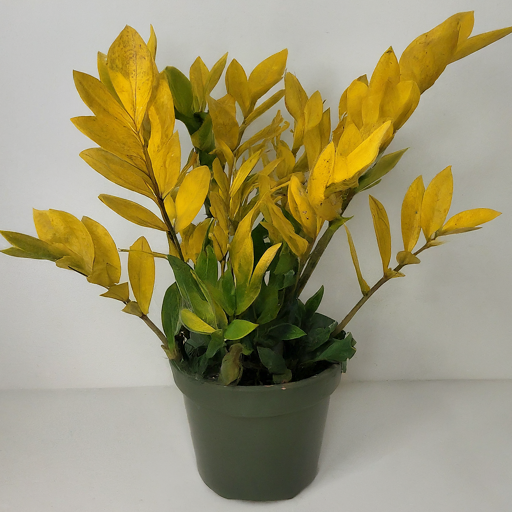
Ah, the ZZ plant. A symbol of low-maintenance elegance, gracing office spaces and apartments alike with its glossy, deep green foliage. But what happens when those once vibrant leaves start to lose their luster, turning a disconcerting shade of yellow? Don’t despair, fellow plant parent! This isn’t necessarily a sign of impending doom. With a little detective work, we can diagnose the cause and get your ZZ plant back to its thriving, green glory.
This post may have affiliate links. This means that sometimes when you click a link on our site and make a purchase on Amazon, we may earn a small commission at no additional cost to you. We only recommend products we truly believe in, and your support helps keep us running!
Table of Contents
Unveiling the Culprit: Why Your ZZ Plant’s Leaves Are Turning Yellow

There are a few key suspects when it comes to yellowing ZZ plant leaves. Let’s delve into the most common ones:
Overhydration Blues
ZZ plants are notorious for their drought tolerance. In their native Zanzibar, they’re accustomed to periods of dry weather. Overwatering is, ironically, the most likely culprit behind those yellowing leaves. Here’s why:
- Root Suffocation: Constant moisture suffocates the roots, hindering their ability to absorb oxygen and nutrients. This disrupts the entire plant’s system, leading to wilting and yellowing leaves.
- Root Rot: Excess water creates a breeding ground for fungus, which can cause root rot. This nasty condition damages the roots further, making it even harder for the plant to take up water and nutrients, accelerating the yellowing process.
Signs Your ZZ is Drowning
- Soil Constantly Moist: Stick your finger a couple of inches into the soil. If it feels damp or soggy, you’re likely overwatering.
- Mushy or Discolored Roots: If you suspect root rot, carefully remove the plant from its pot. Healthy roots should be firm and white. Mushy, brown, or black roots indicate rot.
- Pungent Odor: A foul smell emanating from the pot is another telltale sign of root rot.
Light Misadventures
ZZ plants are known for their adaptability, thriving in both low and medium light conditions. However, getting the light situation wrong can also contribute to yellowing leaves.
- Too Much Sun: While ZZs can tolerate some indirect sunlight, direct sun exposure can scorch the leaves, causing them to turn yellow or brown.
- Light Starvation: On the other hand, ZZs placed in excessively dark corners may not receive enough light to properly photosynthesize. This can lead to stunted growth and yellowing leaves over time.
Light Level Do’s and Don’ts
- Think “Filtered Sunshine”: An east-facing window with indirect morning light is ideal. South or west-facing windows can be too harsh.
- Rotate Your Plant: Regularly rotate your ZZ plant to ensure even growth and prevent leaves on one side from getting significantly more light than the other.
- Don’t Be Afraid of Shade: ZZ plants are happier in lower light conditions compared to many other houseplants.
Restoring Your ZZ Plant to Emerald Glory: A Treatment Plan
Now that you’ve identified the culprit, here’s how to revive your ZZ plant:
Overwatering SOS
- Immediate Action: Stop watering immediately! Allow the soil to dry out completely before watering again.
- Drainage Check: Ensure your pot has drainage holes at the bottom. If not, repot your ZZ plant into a pot with proper drainage.
- Root Rot Rescue: If you suspect root rot, carefully remove the plant from its pot. Prune away any mushy or discolored roots with sterilized shears. Repot the ZZ plant in fresh, well-draining potting mix.
Light Level Adjustments
- For Sunburn Victims: Move your ZZ plant away from direct sunlight. Trim off any severely burnt leaves, as they won’t recover.
- Light-Starved ZZs: If your plant is in a dark corner, consider relocating it to a spot with brighter indirect light.
Additional Tips for ZZ Plant Success
- Watering Wisdom: Water your ZZ plant only when the top inch of soil feels completely dry. A deep watering, allowing excess water to drain through the pot, is better than frequent shallow watering.
- Fertilize Sparingly: ZZ plants don’t require frequent fertilization. A light feeding once or twice a year during the growing season (spring and summer) is sufficient. Opt for a balanced, diluted liquid fertilizer.
- The Right Potting Mix: Use a well-draining potting mix specifically formulated for houseplants. Cactus mix or a mix with added perlite are good options.
